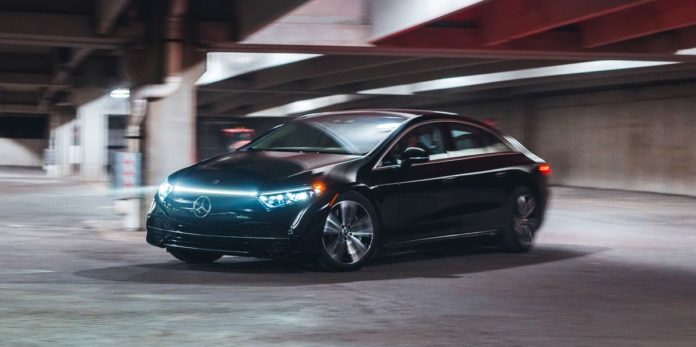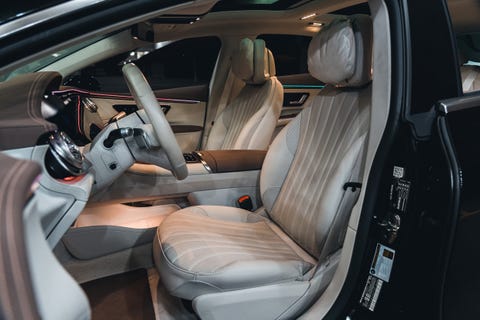UPDATE 1/3/23: This review has been updated with test results.
After you’ve driven nearly every car for sale over the last 20 years, it’s natural for the cars of the past to enter into your thoughts when driving something new. Humans compare experiences to gain perspective, which explains why we were daydreaming about Rolls-Royces while driving Mercedes-Benz’s new electric luxury four-door, the EQS450+.
Like a Rolls-Royce Phantom, the EQS is a capsule of luxury and silence that pours itself down the road with unerring grace. Unlike a hard-to-swallow Rolls, the EQS looks like an Advil Liqui-Gel. It’s a lozenge of a car with what Mercedes claims is the lowest drag coefficient—0.20—of any car on sale. That slick bod whips through the air, barely disturbing it, and leads to near silence at extra-legal highway speeds. At a more reasonable 70 mph, we recorded just 64 decibels of noise inside the cabin.
The 107.8-kWh battery sandwiched in the floor assists in keeping road noise to a minimum. That big battery also allows the EQS450+ to go an estimated 350 miles between charges, according to the EPA. Yet we were able to cover 400 miles on our 75-mph highway test, putting this Benz just behind our current long-range EV champ, the Lucid Air Grand Touring. Find a Level 3 DC hookup and the EQS can go from 10 percent charge to 80 percent in a claimed 31 minutes. On a typical Level 2 setup, the EQS takes just over 11 hours to go from 10 percent to 100 percent.
Moving the electrons around in the battery is a single motor driving the rear wheels that makes 329 horsepower and 417 pound-feet of torque. It’s not nearly as quick as the 516-hp EQS580, but it’ll shove you into the massaging seats. After the initial thrust from a stop the acceleration tapers off, but 60 mph is yours in 5.4 seconds. In more relaxed driving, the right-now torque affords the EQS the same sort of effortless waftability that Rolls-Royce has been touting for decades.
Yet what really reminds us of the Spirit of Ecstasy is the suppleness and silence of the suspension as it glides over the tarmac. Not much of the outside permeates the EQS’s cocoon. The long 126.4-inch wheelbase certainly helps attenuate bumps, but it’s the tuning of the standard air-spring suspension that maintains the serenity despite our test car’s 20-inch wheels wrapped in Goodyear summer rubber.
Those sticky tires provide excellent grip (0.90 g around the skidpad) despite this car’s 5530-pound curb weight. Press it hard into a corner and it remains flat, and the low center of gravity born of the massive battery in the floor seemingly drills the car into the center of the Earth. Steering efforts are light and don’t pick up much even in Sport mode, but the easy efforts help mask the heft and size of this S-class-sized hatchback.
Four-wheel steering turns the rear wheels up to 10 degrees in opposition of the fronts at low speeds, helping to shrink the turning circle to 35.7 feet, making this very big Benz feel like an A-class. There’s an ease and luxury to the whole driving experience that is only interrupted by the brakes. Hitting the brakes in the EQS starts with energy regeneration from the motors and then blends in the stopping power of the four massive brake rotors. Stepping into the brake pedal is an initially mushy experience that doesn’t slow the car much. Keep pushing and you reach a hard point where the pedal resists being moved farther. Press harder and the deceleration finally hits, but it takes a lot of pedal pressure to get meaningful braking, and by then you’re sailing toward that burgundy Corolla at an alarming rate. Give yourself considerably more space than the 167 feet it takes to stop from 70 mph and 351 feet from 100 mph.
Using those unnatural-feeling brakes can be largely avoided by pulling twice on the right paddle behind the steering wheel. Do so and you get the maximum regeneration (what Mercedes terms Recuperation) that largely eliminates the need to touch the brake pedal and allows one to speed up and slow down in traffic by using only the accelerator. That max regen mode won’t bring the car to a complete stop though. The system slows the car to about 5 mph, but the Benz then continues to creep ahead. There is an additional regen mode called Intelligent Recuperation that requires you to hold the right paddle. It utilizes the adaptive cruise-control radar and camera systems to optimize regeneration based on the surrounding traffic, the topography, and the twistiness of the road. When engaged, it’ll bring the car to a stop provided the car in front of you has stopped. It certainly works, but it’s not smart enough to bring the car to a halt at a stop sign or red light and will only react to whatever the vehicle ahead is doing.
Aside from this being Mercedes’s first car built on its new EV platform, the other big news is the so-called Hyperscreen. The EQS450+’s optional Hyperscreen (it’s standard on the EQS580) consists of three screens that are covered in a massive glass panel that spans the width of the dashboard. The three touchscreens control nearly every function in the car, from setting an interior temperature to a game of Tetris. As a new system, it takes a bit of getting used to, but after a few hours of experimentation we became comfortable with scrolling through radio stations, looking up the outside air quality, setting a destination on the native navigation system, and pairing a phone to the system. Once paired, we largely skipped Benz’s system for Apple CarPlay. There is also the option of talking to the EQS. Saying “Hey, Mercedes” wakes the EQS’s virtual assistant that can help with a number of controls, from setting the temperature to making a phone call. It works surprisingly well, but talking to your car always seems a little silly.
The Hyperscreen certainly looks like the future, but the instrument display in front of the driver is set high. That elevated cowl is the exact opposite of the low and simple dashboard of a Tesla Model 3 or even a Model S. The brain adjusts to it, but without an engine ahead of you, why does the cowl need to be so high?
We also questioned the lack of a frunk. A cabin air filter and some other ancillaries live under the fixed hood, but the EQS makes up for that deficiency with an absolutely massive amount of cargo space under the rear hatch (22 cubic feet, or enough to swallow eight carry-on suitcases). And, if that’s not enough, the rear seats fold away.
There’s also a lot of space in the rear seat—leg-crossing, stretch-out space. Sitting in the rear seat you realize that this car is a reimagining of the S-class. In addition to the S-class appointments, performance, technology, and space inside, the EQS comes with an S-class-like price. The least expensive EQS450+ starts at $105,450, with our test car reaching $118,395 with a host of options. Pricing for the more powerful EQS580 opens at $126,945 and escalates from there. Aside from the acceleration, the smaller-motor EQS450+ is the same luxurious experience as the more powerful sibling. If you never floor it for more than a couple of seconds, you’ll never feel like you should have gone with the quicker car. The EQS450+ is just as quiet, just as refined, and just and lovely as the more expensive EQS580. So, for those who don’t think every car that’s next to you at a red light is competition, you’ll be just fine.
Specifications
Specifications
2022 Mercedes-Benz EQS450+
Vehicle Type: rear-motor, rear-wheel-drive, 5-passenger, 4-door hatchback
PRICE
Base/As Tested: $105,450 /$118,395
Options: MBUX Hyperscreen package (12.3-inch driver display, 17.7-inch center display, 12.3-inch passenger display), $7230; Natural Grain Yacht-Design Brown Walnut trim with aluminum lines, $1515; multicontour front seats with massage, $1100; laminated safety glass, $1010; active ambient lighting, $590; Energizing Air Control Plus with HEPA filter, $450; rapid heating front seats, $450; emergency-use 110-volt charging cable, $250; dashcam, $200; integrated toll-payment system, $200; 20-inch wheels with summer tires, $0; Valet/Beginner drive mode delete credit, -$50
POWERTRAIN
Motor: permanent-magnet synchronous AC, 329 hp, 417 lb-ft
Battery Pack: liquid-cooled lithium-ion, 107.8 kWh
Onboard Charger: 9.6 kW
Peak DC Fast-Charge Rate: 200 kW
Transmission: direct-drive
CHASSIS
Suspension, F/R: multilink/multilink
Brakes, F/R: 15.4-in vented disc/14.9-in vented disc
Tires: Goodyear Eagle F1 Asymmetric 5
255/45R-20 105H Extra Load MO
DIMENSIONS
Wheelbase: 126.4 in
Length: 207.3 in
Width: 75.8 in
Height: 59.6 in
Passenger Volume, F/R: 58/45 ft3
Cargo Volume, Behind F/R: 63/22 ft3
Curb Weight: 5530 lb
C/D TEST RESULTS
60 mph: 5.4 sec
100 mph: 13.6 sec
1/4-Mile: 14.0 sec @ 101 mph
130 mph: 25.1 sec
Results above omit 1-ft rollout of 0.3 sec.
Rolling Start, 5–60 mph: 5.5 sec
Top Gear, 30–50 mph: 2.1 sec
Top Gear, 50–70 mph: 3.0 sec
Top Speed (gov ltd): 130 mph
Braking, 70–0 mph: 167 ft
Braking, 100–0 mph: 351 ft
Roadholding, 300-ft Skidpad: 0.90 g
C/D FUEL ECONOMY
Observed: 83 MPGe
75-mph Highway Range: 400 mi
EPA FUEL ECONOMY
Combined/City/Highway: 97/97/97 MPGe
Range: 350 mi
C/D TESTING EXPLAINED
This content is imported from OpenWeb. You may be able to find the same content in another format, or you may be able to find more information, at their web site.



